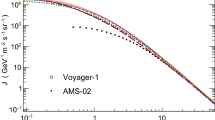Abstract
From a careful examination of the diurnal variation of cosmic ray intensity at high energies and the interplanetary field characteristics, the average characteristics of diurnal variation were recently explained by us in terms of a balance between outward convection and field aligned diffusion, the latter arising out of a positive radial density gradient. In this paper, we extend this new concept to explain the large variability observed in the diurnal variation on a day-to-day basis and further demonstrate that the measurement of diurnal anisotropy characteristic of cosmic ray particles on a day-to-day basis can be used directly to infer the nature and scale sizes of interplanetary field parameters. Comparing with the magnetic field vector, we show that this simple concept holds good on more than 80% of days. On the rest 20% of days which have a predominant morning maxima, the diurnal anisotropy characteristics seem to indicate the presence of a significant component of transverse diffusion current in addition to the normal convection and diffusion flow. Such days are found to be present in the form of trains of consecutive days and are found to be associated with abrupt changes in the interplanetary field direction having scale sizes >4 hr. The value ofK ⊥/K ‖ which is normally about ⩽0.05 is found to be ≈1.0 on non-field aligned days.
Similar content being viewed by others
References
Bame S O, Asbridge J R, Hundhausen A J and Strong I B 1967Trans. Amer. Geophys. Union Abstract 48 190
Forman M A and Gleeson L J 1970 Preprint Manash University
Gleeson L J 1969Planet. Space Sci. 17 31
Hashim A, Bercovitch M and Steljes J F 1972Solar Phys. 22 220
McCracken K G, Rao U R, Fowler B C, Shea M A and Smart D F 1965IQSY Instruction Manual No. 10.
McCracken K G and Rao U R 1965Proc. Cosmic Ray Conf. (London) 1 213
McCracken K G, Rao U R and Ness N F 1968J. Geophys. Res. 73 4159
McCracken K G, Rao U R, Bukata R P and Keath E P 1971Solar Phys. 18 100
O’Gallagher J J 1972Rev. Geophys. Space Phys. 10 821
Owens A J and Jokipii J R 1972J. Geophys. Res. 77 6639
Pai G L, Bridge H S, Lyon E F and Egidi A 1967Trans. Amer. Geophys. Union 48 176
Patel D, Sarabhai V and Subramanian G 1968Planet. Space Sci. 16 1131
Rao U R, McCracken K G and Venkatesan D 1963J. Geophys. Res. 68 345
Rao U R and Sarabhai V 1964Planet. Space Sci. 12 1055
Rao U R 1972Space Sci. Rev. 12 719
Rao U R, Ananth A G and Agrawal S P 1972Planet. Space Sci. 20 1799
Snyder C W, Neugebauer M and Rao U R 1963J. Geophys. Res. 68 6361
Subramanian G 1971J. Geophys. Res. 76 1093
Author information
Authors and Affiliations
Rights and permissions
About this article
Cite this article
Ananth, A.G., Agrawal, S.P. & Rao, U.R. Study of cosmic ray diurnal variation on a day-to-day basis. Pramana - J. Phys 3, 74–88 (1974). https://doi.org/10.1007/BF02847116
Received:
Issue Date:
DOI: https://doi.org/10.1007/BF02847116




